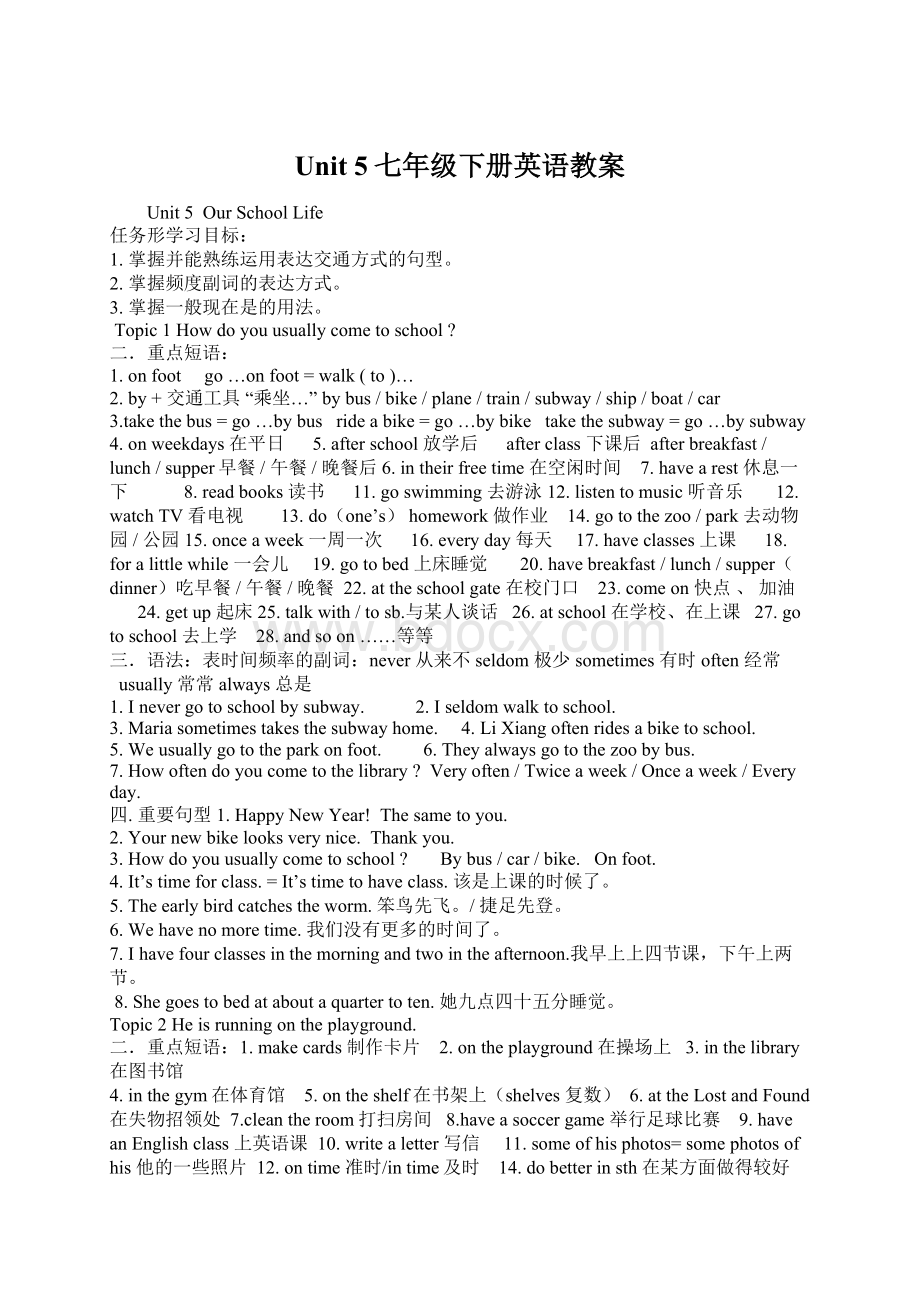Unit 5七年级下册英语教案.docx
《Unit 5七年级下册英语教案.docx》由会员分享,可在线阅读,更多相关《Unit 5七年级下册英语教案.docx(13页珍藏版)》请在冰豆网上搜索。

Unit5七年级下册英语教案
Unit5 OurSchoolLife
任务形学习目标:
1. 掌握并能熟练运用表达交通方式的句型。
2. 掌握频度副词的表达方式。
3. 掌握一般现在是的用法。
Topic1Howdoyouusuallycometoschool?
二.重点短语:
1.onfoot go…onfoot=walk(to)…
2.by+交通工具“乘坐…”bybus/bike/plane/train/subway/ship/boat/car
3.takethebus=go…bybus rideabike=go…bybike takethesubway=go…bysubway
4.onweekdays在平日 5.afterschool放学后 afterclass下课后 afterbreakfast/lunch/supper早餐/午餐/晚餐后6.intheirfreetime在空闲时间 7.havearest休息一下 8.readbooks读书 11.goswimming去游泳12.listentomusic听音乐 12.watchTV看电视 13.do(one’s)homework做作业 14.gotothezoo/park去动物园/公园15.onceaweek一周一次 16.everyday每天 17.haveclasses上课 18.foralittlewhile一会儿 19.gotobed上床睡觉 20.havebreakfast/lunch/supper(dinner)吃早餐/午餐/晚餐 22.attheschoolgate在校门口 23.comeon快点、加油 24.getup起床25.talkwith/tosb.与某人谈话 26.atschool在学校、在上课 27.gotoschool去上学 28.andsoon……等等
三.语法:
表时间频率的副词:
never从来不seldom极少sometimes有时often经常 usually常常always总是
1.Inevergotoschoolbysubway. 2.Iseldomwalktoschool.
3.Mariasometimestakesthesubwayhome. 4.LiXiangoftenridesabiketoschool.
5.Weusuallygototheparkonfoot. 6.Theyalwaysgotothezoobybus.
7.Howoftendoyoucometothelibrary?
Veryoften/Twiceaweek/Onceaweek/Everyday.
四.重要句型1.HappyNewYear!
Thesametoyou.
2.Yournewbikelooksverynice. Thankyou.
3.Howdoyouusuallycometoschool?
Bybus/car/bike. Onfoot.
4.It’stimeforclass.=It’stimetohaveclass.该是上课的时候了。
5.Theearlybirdcatchestheworm.笨鸟先飞。
/捷足先登。
6.Wehavenomoretime.我们没有更多的时间了。
7.Ihavefourclassesinthemorningandtwointheafternoon.我早上上四节课,下午上两节。
8.Shegoestobedataboutaquartertoten.她九点四十五分睡觉。
Topic2Heisrunningontheplayground.
二.重点短语:
1.makecards制作卡片 2.ontheplayground在操场上 3.inthelibrary在图书馆
4.inthegym在体育馆 5.ontheshelf在书架上(shelves复数) 6.attheLostandFound在失物招领处 7.cleantheroom打扫房间 8.haveasoccergame举行足球比赛 9.haveanEnglishclass上英语课 10.writealetter写信 11.someofhisphotos=somephotosofhis他的一些照片 12.ontime准时/intime及时 14.dobetterinsth在某方面做得较好 15.puton穿、戴上、上演(代词it/them放在中间,名词中间或后面,putit/themon) 16.showsb.around…令某人参观……
三.语法:
现在进行时态 主语+be(is/am/are)+动词ing+其他。
表示正在进行或发生的动作。
常与now=atthemoment现在、look看、listen听等连用。
1.I’mlookingformypurse. 2.Theyaren’tsleepingatthemoment.
3.Areyoudoingyourhomework?
Yes,Iam. No,I’mnot.
4.Ishe/shesingingnow?
Yes,he/sheis. No,he/sheisn’t.
5.Whatisyourbrotherdoing?
Heisrunninginthegym.
四.重要句型www.
1.Excuseme,mayIborrowyourstorybook?
Ofcourse.=Sure.(borrowsthfrom…从……借回某物……)
2.HowLongmayIkeepthebook?
Twoweeks.(keep借用,后面常跟一段时间连用)
3.Youmustreturnthemontime.(return归还,returnsth to…把……归还给……)
4.Thankyou.It’sapleasure.=Apleasure=Mypleasure.别客气。
5.Sorry,Idon’thaveany. Thankyouallthesame.仍然感谢你。
6.Seeyousoon.回头见. 7.Whatelse?
还有别的什么?
(else其他的、别的,常放在疑问词what/where/who…和不定代词something/somebody等的后面)
Topic3Myschoollifeisveryinteresting.
二. 重点短语:
1.outdooractivity课外活动 2.easyandinteresting容易又有趣 3.difficultandboring又难又乏味 4.befriendlytosb.=bekindtosb.对某人友好 5.between…and…在……之间… 6.learn…from…向……学习……/从…中学……7.from…to…从……到…… 8.inthemorning/afternoon/evening在早上/下午/晚上9.onMonday在星期一 onMondaymorning在星期一的早上 11.tellsb.aboutsth告诉某人关于某事
三.语法:
一般现在时主语+动词原形/动词第三人称单数s/es+其他。
表示经常或习惯性的动作。
常与频率副词:
never从来不seldom极少sometimes有时often经常 usually常常always总是或everyday每天、inthemorning/afternoon/evening在早上/下午/晚上等连用。
例如:
Ioftendomyhomeworkintheevening. Idon’toftengoshoppingonSunday.
Doyouusuallycometoschoolbycar?
Yes,Ido. No,Idon’t.
SometimesshewatchesTVintheevening. Shedoesn’tlikeChinese.
Doessheoftentakeabustoschool?
Yes,shedoes. No,shedoesn’t.
四.重要句型
1.Whatdayisittoday?
It’sSunday/Monday/Tuesday/Wednesday/Thursday/Friday/Saturday.(在英语国家每周的第一天是星期天而不是星期一)
2.Whatclassaretheyhaving?
Theyarehavingamusicclass.
3.Whattimedoestheclassbegin?
Atteno’clock.
4.Whatdoyouthinkofmath?
=Howdoyoulikemath?
你认为数学怎么样?
It’sdifficultandboring.
5.Why(为什么)doyoulikeEnglish?
Because(因为)it’seasyandinteresting.
7.Whatsubject(学科)doyoulikebest?
Ilikehistorybest.
8.Atschool,myteachersandclassmatesareveryfriendlytome.
9.IstudyChinese,English,politics,geographyandsomeothersubjects.(other泛指其他的,别的+名词复数)
10.Englishismyfavorite(最喜欢的)subject.IalsolikeP.Eandmusic.=IlikeP.Eandmusic,too.(也)
11.Canyoutellmesomethingaboutit?
五.词语辨析
afew几个,一些+名词复数 alittle一点儿+不可数名词 many许多+名词复数 few几乎没有 little几乎没有 much许多、大量的+不可数名词
other泛指其他的,别的+名词复数 another泛指又一个、再一个、另一个+名词单数 theother两者中的另一个
Unit6OurLocalArea
Topic1 Isthereasofainyourstudy?
一、学习目标
1、掌握单词和重点词组
2、掌握therebe的各种形式及用法
3、能熟练用英语描写房间、家庭、学校等建筑
4、熟练掌握方位介词in,on,behind,under,near,nextto,infrontof
二、重点词组
Onthefirstfloor 美式英语一楼floor地板,此处指“楼房的层”。
英式英语用thegroundfloor表示一楼
1. Whynot=Whydon’tyou 复习其他提建议的方式
2. Goupstairs上楼 Godownstairs 下楼
3. Amomentlater 一会以后
4. Youhaveanicestudy。
study名词:
书房动词:
学习与learn的区别
5. Inthefrontofthehouse在屋子(里面的)前面 Infrontofthehouse在屋子(外面的)前面
6. Talkabout谈论 talkwithsb.和某人谈论
7. Putthemaway把他们收拾好
8. Lookafter=takecareof 照顾,看管
9. Inthetree(非树本身的东西)在树上 Onthetree(树本身的东西)
10. Ontheriver浮在水面上 overtheriver在河上(悬空)
11. Onthewall在墙上 inthewall 在墙里
12. Getaletterfromsb=hearfromsb 注意hearfrom宾语是人不是信,herof听说某人(物),hear听到,听见,侧重听的结果。
常用hearsbdoingsth/dosth
13. Tellsbaboutsth Tellsbtodosth Tellsbsth
14. wantsbtodosth/wanttodosth
三、语法知识:
Therebe句型的用法
Therebe句型是英语中常见的特殊句型,用以表示某物某事存在或不存在。
句中的there只起引导作用,并无实际意义,句子的真正主语是谓语动词be后面的名词。
1、在therebe句型中,谓语动词be要与主语(某人或某物)的数保持一致。
当主语是两个或两个以上的名词时,谓语动词要与跟它最近的那个名词一致。
eg. ①Thereisabirdinthetree.
②Thereisateacherandmanystudentsinourclassroom.
③Therearetwoboysandagirlunderthetree.
2、Therebe句型与have的区别:
Therebe句型和have都表示“有”的含义。
区别如下:
Therebe表示“某处存在某物或某人”;have表示“某人拥有某物/某人”,它表示所有、拥有关系。
eg.①Hehastwosons.
②Therearetwomenintheoffice.
当have表示“包括”、“存在”的含义时,Therebe句型与其可互换。
eg. Aweekhassevendays.=Therearesevendaysinaweek.
3、否定句
Therebe句型的否定式的构成和含有be动词的其它句型一样,在be后加上not或no即可。
注意not和no的不同:
not是副词,no为形容词,nota/an/any+n.相当于no+n.。
例如:
Therearesomepicturesonthewall.→Therearen'tanypicturesonthewall.=Therearenopicturesonthewall.
Thereisabikebehindthetree.→Thereisn'tabikebehindthetree.=Thereisnobikebehindthetree.
4、特殊疑问句
Therebe句型的特殊疑问句形式有以下三种变化:
①对主语提问:
当主语是人时,用\"Who\'s+介词短语?
\";当主语是物时,用\"What\'s+介词短语?
\"。
注意:
无论原句的主语是单数还是复数,对之提问时一般都用be的单数形式(回答时却要根据实际情况来决定)。
如:
Therearemanythingsoverthere.→What'soverthere?
Thereisalittlegirlintheroom.→Whoisintheroom?
②对地点状语提问:
提问地点当然用"Whereis/are+主语?
\"啦!
例如:
Thereisacomputeronthedesk.→Whereisthecomputer?
Therearefourchildrenontheplayground.→Wherearethefourchildren?
③对数量提问:
一般有两种句型结构:
Howmany+复数名词+arethere+介词短语?
Howmuch+不可数名词+isthere+介词短语?
usedto表示过去常常做某事.
例句:
Iusedtoplayfootballafterschool.过去我常常在放学后踢球.
beusedtodo的意思是被用来做某事;beusedtodoing的意思是习惯于做某事.
usedto+do:
"过去常常"表示过去习惯性的动作或状态,但如今已不存在。
Motherusednottobesoforgetful.
Scarfusedtotakeawalk.(过去常常散步)
beusedto+doing:
对……已感到习惯,或"习惯于",to是介词,后需加名词或动名词。
Heisusedtoavegetariandiet.
Scarfisusedtotakingawalk.(现在习惯于散步)
Topic2What’syourhomelike?
重点语法:
Therebe句型
① Therebe句型的否定句
② Therebe句型的疑问句
③Therebe句型的就近原则
④Therebe句型的反意疑问句
⑤Therebe句型与have/has的区分
重点短语:
belike/anapartmentbuilding/atownhouse/inthesurburbs/
onthestreetcorner/rentahousewithfurnituretoothers/keepmoney
重点句型:
①What’syourhomelike?
②What’sthematter……?
③Ihearyouplayingthepiano.
④Ican’thearyou,thelineisbad.
⑤I’llgetsomeonetocheckitrightnow.
⑥Thetrafficisheavyandthecostoflivingishigh.
⑦Therearemanyoldpeopleandmanyfamilieswithyoungchildrenlivingthere.
点拨:
㈠What’syourhomelike?
Like动词“喜欢”,介词“像”。
belike像和looklike看起来像。
belike主要用来询问人的性格、外貌和事物特征。
Looklike主要用来询问外貌。
㈡forrent出租。
wanted求租.rentsthtosb把某物租给某人rentsthfromsb从某人处租某物。
㈢callsbat+号码。
请打......电话与某人联系。
㈣Ihearyouplayingthepiano.
hearsbdoingsth听见某人正在做某事(强调动作进行)
hearsbdosth(强调全过程)
㈤Manyshopsandrestaurantsareclosetomyhome.
becloseto离……近。
close与near都有“靠近”的意思,但close比near更近。
Topic3Whichisthewaytothepostoffice?
重点语法:
祈使句
①肯定、否定形式。
②特例。
重点短语:
aticketforspeeding超速罚单 attheendoftheroad在路的尽头 goacross走过 turnleft/right向左转/向右转 onthecornerof在。
。
。
转角/拐弯处 acrossfrom在。
。
。
对面 between……and在。
。
。
之间 taketheNo.718bus乘坐718路公共汽车 changeto变成 noparking禁止停车 gethurt受伤 obeythetrafficrules遵守交通规则 keepontherightoftheroad保持在路的右边 atthefootof 在。
。
。
的脚下 holdsthinone’shand抓住某人的手
重点句型:
一.问路语
① Whereis……?
② Istherea……nearhere?
③ Whichisthewayto……?
④ HowcanIgetto……?
⑤ Couldyoutellmethewayto……?
二.指路
①Goalong/downthisroaduntil……
②Turnleftatthefirstturning﹦Takethefirstturningontheleft.
③Gostraightaheadandyouwillsee……
④It’sabout15kilometresawayfromhere.
三.Thankyouallthesa